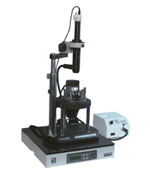
Scanning Probe Microscope Solver EC
A Solver EC system is intended to perform the electrochemical studies of adsorption layers formation, metals deposition and dissolution in combination with in situ monitoring the electrode/solution interface morphology by STM with atomic scale resolution and tunnel spectros-copy. The system consists of the following:
The bipotentiostate makes it possible to carry out various electrochemical experiments in potentiostatic, potentiodynamic and galvanostatic modes. Potentials of the working electrode and probe are set independently relative to the reference electrode. The specific universal pro-grammator gives the user practically unlimited opportunities to perform automatized electro-chemical measurements. The electrode polarization program can consist of 10 steps and each of them allows to execute independently various electrochemical actions the required number of times in the given range of current and frequency. For example, during some program steps the electrode preprocessing can be accomplished (potentiostatic polarization with chronoampero-grams registration, linear potential ramp at given rate or cyclic voltamperometry, open circuit stationary potential measurements, etc.) while during other steps it is possible to execute the po-tentiostatic or galvanostatic metals deposition with a series of current transients at different po-tentials registration and automatic recording of measurement results on disc. The bipotentiostate software provides the user-friendly interface for conducting the electrochemical experiments, data express analysis and processing. One of the instrument features is the ability to use the high quality hemispherical single crystals of noble metals produced in many leading laboratories in the world by Clavilier's method. Di-ameter of such single crystals is normally under 3-4 mm. To use them one needs the electro-chemical microcells of special design which are the components of this instrument.
|
||||||||||||||||||||||||||||||||||||||||||||||||||||||||
Seek Inter Corporation Limited. |
